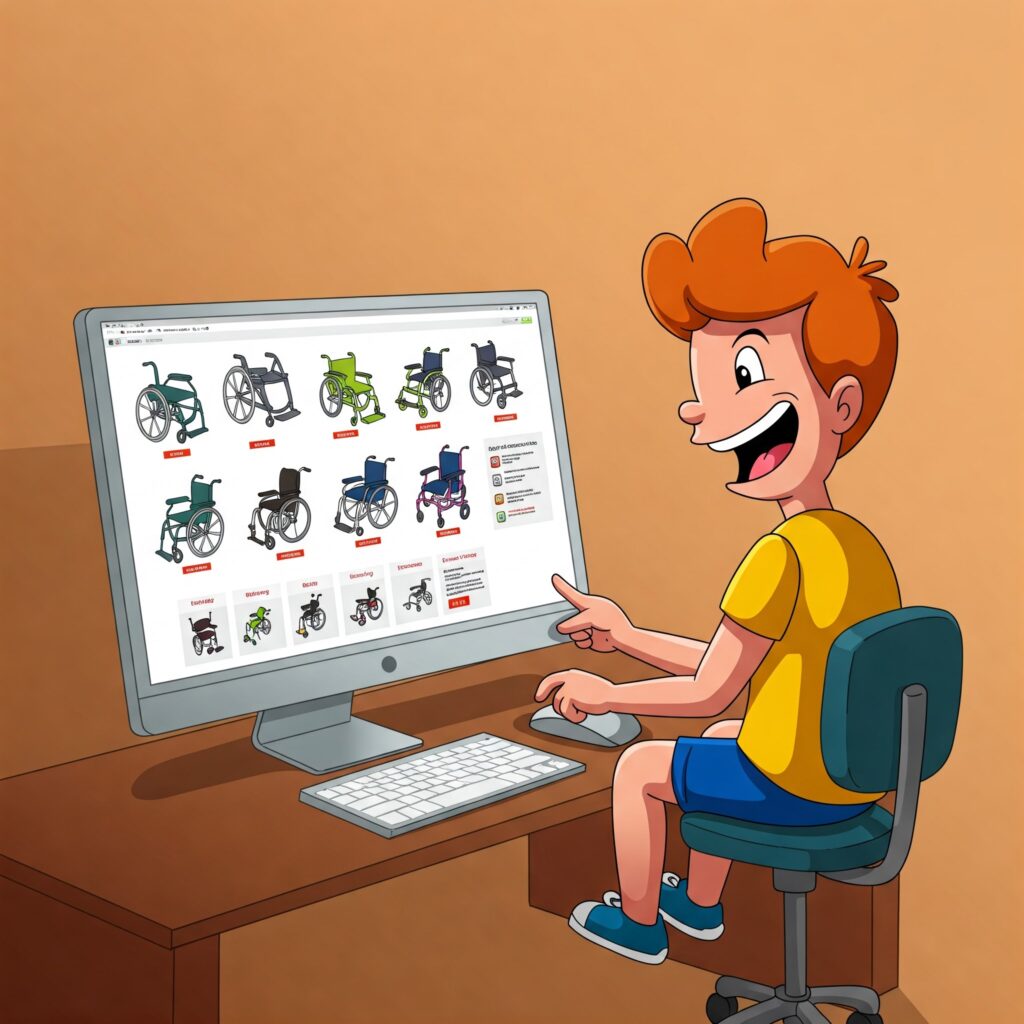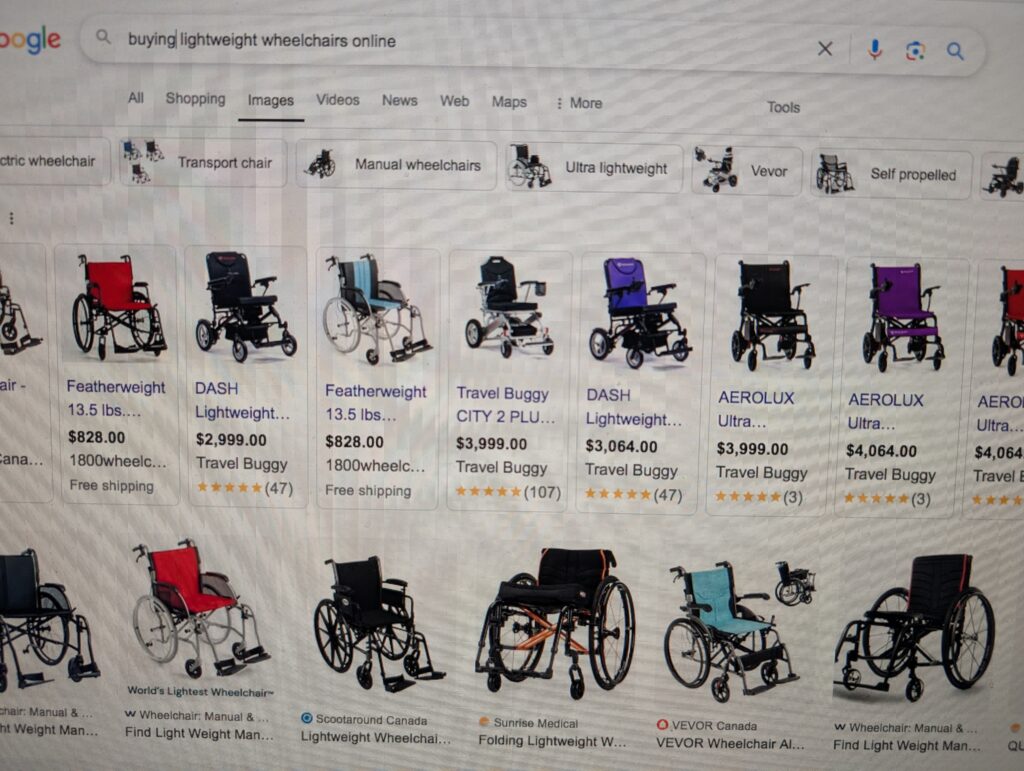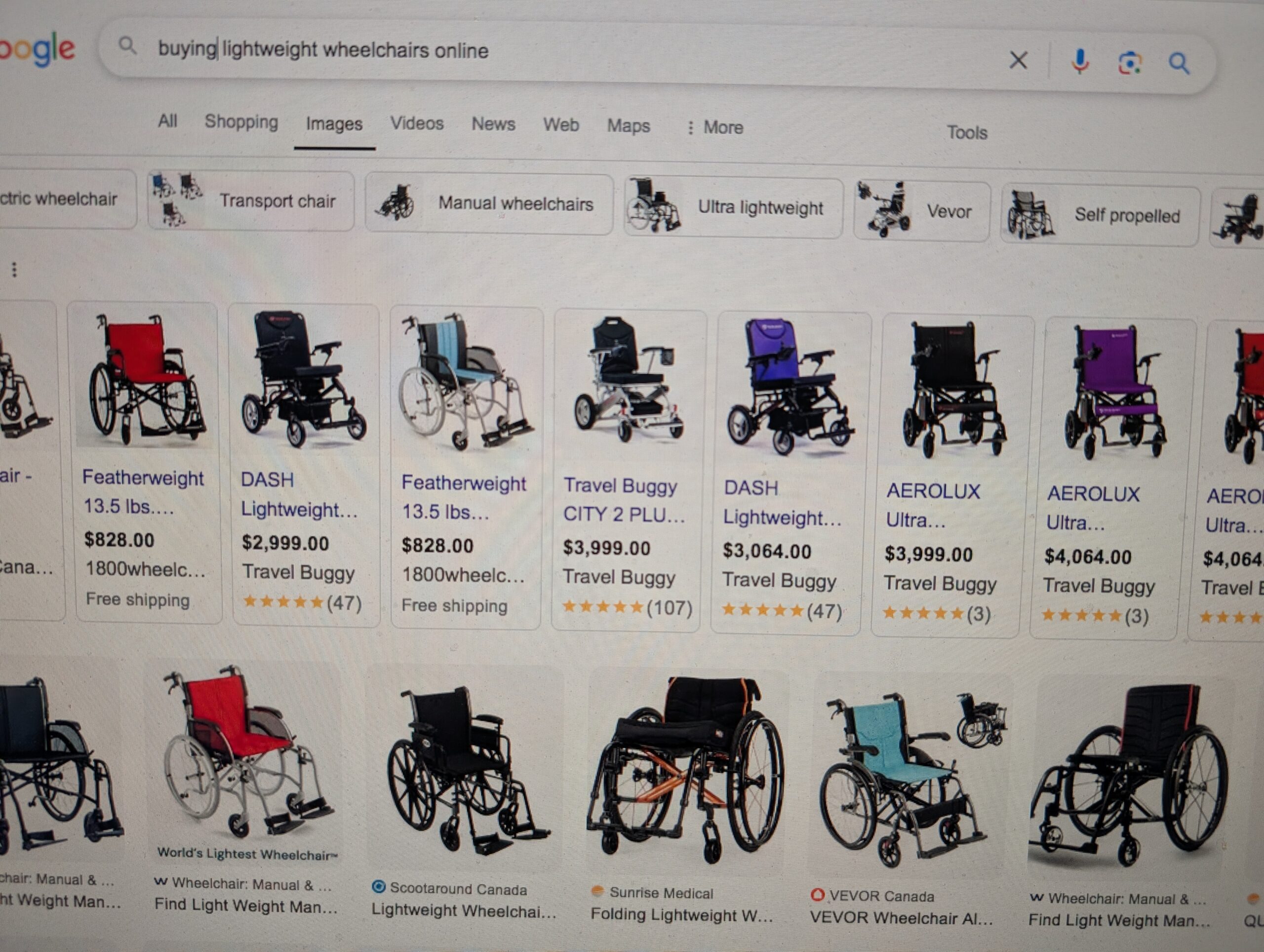Finding the perfect lightweight wheelchair can feel like navigating a maze, especially when shopping online. But imagine the freedom and increased mobility a well-chosen, lightweight wheelchair can bring – easily navigating crowded spaces, traveling with less hassle, and simply enjoying greater independence. With the rise of online shopping, even for specialized medical equipment like wheelchairs, it’s crucial to be an informed consumer. This article provides ten essential tips to guide you through the process of buying a lightweight wheelchair online, ensuring you make a confident and informed purchase that meets your specific needs for comfort, safety, and enhanced mobility.
Tip 1: Prioritize In-Person Evaluation
Before diving into the world of online lightweight wheelchair shopping, a crucial first step is to prioritize an in-person evaluation with a qualified occupational therapist (OT) or physical therapist (PT). This professional assessment is the cornerstone of successful wheelchair selection, ensuring not only a proper fit but also addressing your specific needs and safety concerns. Think of it as building the foundation for your mobility and independence. This initial investment in professional guidance can save you time, money, and potential discomfort down the road.
Professional Assessment: A thorough evaluation by an OT or PT is invaluable. They possess the expertise to assess your physical capabilities, limitations, and specific needs related to mobility. This assessment will consider factors like your strength, range of motion, posture, and any existing medical conditions. The therapist will also observe how you move and interact with your environment, providing insights into the type of wheelchair that will best support your lifestyle.
Guidance for Wheelchair Selection: Based on the evaluation, the OT or PT can guide you toward the most appropriate type of lightweight wheelchair. They can help you understand the various features available, such as manual vs. power-assisted, folding vs. rigid frames, and the different types of wheels and casters. This professional guidance helps you narrow down your options and focus your online research.
Ensuring Proper Fit and Addressing Safety: A proper fit is paramount for comfort, efficiency, and preventing secondary health issues. The therapist will take precise measurements to ensure the wheelchair’s seat width, depth, and height are tailored to your body. They will also assess your posture and recommend appropriate backrest and cushion options for optimal support. Furthermore, the evaluation will address any safety concerns related to transferring, maneuvering in different environments, and potential risks associated with specific wheelchair features.
Preparing for the Evaluation with Online Research: While the in-person evaluation is essential, online research can play a valuable role in preparing you for it. Familiarizing yourself with different lightweight wheelchair types (e.g., folding, rigid, ultra-lightweight), features, and specifications will enable you to have a more informed conversation with your therapist. Understanding the terminology and basic functionalities will allow you to ask more targeted questions and actively participate in the decision-making process. This proactive approach will empower you to make the most of your evaluation and ultimately choose the best lightweight wheelchair for your individual needs. Remember, this is a collaborative process, and your input is crucial.

Tip 2: Conduct a Thorough Needs Assessment
Before diving into online lightweight wheelchair shopping, a comprehensive needs assessment is crucial. This process involves carefully considering various factors related to the user’s lifestyle, environment, and specific requirements. A well-defined needs assessment will guide your wheelchair selection, ensuring you choose a model that truly enhances mobility and independence. This is a vital step in any lightweight wheelchair buying guide.
- Primary Use (Indoor, Outdoor, or Both): Will the wheelchair primarily be used indoors, outdoors, or a combination of both? Indoor use might prioritize maneuverability in tight spaces, while outdoor use may require more robust wheels and a frame designed for varied terrain. Understanding the primary use will help narrow down the suitable wheelchair features and specifications.
- Terrain Encountered (Even/Uneven Surfaces, Ramps, Stairs): Consider the types of surfaces the wheelchair will encounter. Will it be used on smooth, paved surfaces, or will it need to navigate uneven terrain, gravel paths, ramps, or even occasional stairs? The terrain will influence the choice of wheels, tires, and suspension (if available). For example, larger rear wheels are generally better suited for uneven surfaces.
- Portability Requirements (Folding, Disassembly, Transportation): How often will the wheelchair need to be transported? If frequent transport is required, a lightweight wheelchair with a quick and easy folding mechanism is essential. Consider whether the wheelchair needs to fit in a car trunk or be easily maneuvered onto public transportation. Some models offer the option for disassembly for even more compact storage. Think about the user’s strength and ability to manage the folding and lifting process. Wheelchair portability is a key factor for many wheelchair users.
- Self-Propelling vs. Caregiver Push Needs: Will the user be self-propelling the wheelchair, or will a caregiver be pushing? This will significantly impact the choice of features. Self-propelling wheelchairs often feature larger rear wheels and hand rims, while caregiver-pushed wheelchairs may prioritize lighter weight and maneuverability for the caregiver. The user’s upper body strength and endurance should be carefully considered when determining the best option. This aspect of wheelchair selection is crucial for both the user’s comfort and the caregiver’s ease of use.
Tip 3: Measure Carefully
Accurate measurements are absolutely crucial when buying a lightweight wheelchair online. Since you can’t physically try the chair before purchasing, getting the right fit is paramount for comfort, safety, and proper function. Incorrect measurements can lead to discomfort, pressure sores, difficulty propelling the chair, and even instability. Taking the time to measure carefully will save you time, money, and potential frustration in the long run. This step is essential for anyone looking for the perfect mobility aid, especially when considering factors like wheelchair portability and maneuverability.
Body Measurements:
Accurate body measurements are the foundation of a proper wheelchair fit. You’ll need to measure several key areas, including:
- Seat Width: Measure the widest point of the user’s hips while seated. Add about an inch on each side for comfort and to accommodate clothing.
- Seat Depth: Measure from the back of the knee to the back of the hip. This measurement determines the appropriate seat depth.
- Seat Height: Measure from the back of the knee to the floor while seated. This measurement is crucial for proper footrest placement and preventing pressure on the back of the thighs.
Home Environment Measurements:
Don’t forget to consider your home environment. A perfectly fitted wheelchair won’t do you much good if it can’t navigate through your doorways or hallways.
- Doorways: Measure the width of all doorways the wheelchair will need to pass through.
- Hallways: Measure the width of hallways to ensure easy maneuverability.
- Other Obstacles: Consider any other potential obstacles, such as ramps, elevators, or tight corners.
Measuring Checklist and Guides:
To ensure accuracy, create a simple checklist of all the measurements you need to take. You can also find helpful measuring guides or templates online, often provided by wheelchair manufacturers or retailers. These resources can offer visual aids and step-by-step instructions to help you through the process. Remember, accurate measurements are key to finding the right wheelchair for your needs and maximizing your comfort and mobility.

Tip 4: Research Key Features
Choosing the right lightweight wheelchair involves understanding the various features available and how they impact performance, comfort, and usability. Don’t just focus on the overall look; delve into the specifics to ensure the wheelchair meets your individual needs and lifestyle. Thorough research into these key features is crucial for a successful online purchase.
Frame Materials: The frame is the backbone of the wheelchair, and its material significantly influences weight and durability. Aluminum is a common choice, offering a balance of strength and lightness. Titanium frames are similarly light but come at a higher price point. For those seeking the absolute lightest option, carbon fiber wheelchairs are available, though they are typically the most expensive. Understanding the properties of each material will help you make an informed decision based on your needs and budget.
Folding Mechanisms: Portability is a key consideration for lightweight wheelchairs. Different folding mechanisms exist, each with its own advantages. Some wheelchairs fold compactly for easy storage in a car or closet, while others may offer a quick-release mechanism for easier transport. Consider how often you’ll be folding and transporting the wheelchair and choose a mechanism that suits your lifestyle and strength. Ease of use is paramount; ensure you can easily fold and unfold the chair yourself.
Seat and Backrest: Comfort is essential, especially for prolonged use. Look for adjustable seat and backrest options to ensure proper posture and support. Consider features like breathable materials to prevent pressure sores and enhance comfort. Some wheelchairs offer customizable cushions and backrests for personalized support, which can significantly improve the user experience. Think about the type of activities you’ll be doing in the wheelchair and how that impacts your comfort needs.
Caster Size and Type: Casters are the small front wheels that affect maneuverability. Larger casters generally provide a smoother ride, especially on uneven surfaces, making them suitable for outdoor use. Smaller casters are more agile and better suited for indoor environments with tight spaces. Consider the terrain you’ll be navigating most frequently when choosing caster size and type. Also, consider the material of the casters; some are designed for increased durability or better grip.
Tip 5: Read Reviews Critically
User reviews offer invaluable insights into the real-world performance and user experience of lightweight wheelchairs. Beyond simply looking at star ratings, a critical approach to reading reviews is essential for making an informed decision. These reviews can highlight aspects of the wheelchair that might not be immediately apparent from product descriptions or specifications, offering a glimpse into how the chair performs in everyday situations for various wheelchair users. By carefully considering what other buyers have to say, you can gain a better understanding of whether a particular model meets your needs in terms of durability, comfort, ease of use, and portability.
Durability and Construction: Look for reviews that comment on the long-term durability of the wheelchair. Do reviewers mention any issues with the frame, wheels, or other components after extended use? Have they had any problems with parts breaking or needing replacement? This information can help you avoid purchasing a chair that might require frequent repairs or replacements. Reading about the experiences of other wheelchair users with the frame materials (aluminum, titanium, carbon fiber) can give you more confidence in the product’s longevity.
Comfort and Ergonomics: Comfort is paramount when choosing a lightweight wheelchair. Pay attention to reviews that discuss the comfort of the seat and backrest, especially for prolonged use. Do reviewers find the seat and backrest supportive? Is the upholstery durable and easy to clean? Are there any comments about pressure sores or other comfort-related issues? Reviews mentioning adjustability features, like armrests and footrests, can also be helpful.
Ease of Use and Portability: For many, portability is a key factor in choosing a lightweight wheelchair. Focus on reviews that address how easy the chair is to fold, lift, and transport. Do reviewers find it easy to maneuver, both indoors and outdoors? Are there any comments about the weight of the chair and whether it is manageable for the user or caregiver? Real-world feedback on folding mechanisms and overall portability can be especially valuable.
Common Issues and Potential Problems: Reviews can often highlight common issues or potential problems associated with a particular wheelchair model. Are there any recurring complaints about specific features, such as the brakes, wheels, or folding mechanism? Has anyone mentioned difficulties with assembly or adjustments? Being aware of potential problems beforehand can help you make a more informed decision and avoid any surprises after your purchase. Consider also if the reviews mention any struggles with uneven surfaces or various terrains.
Identifying Reliable Reviews: It’s important to be able to distinguish between genuine reviews and those that may be biased or unreliable. Look for reviews that are detailed and specific, rather than just generic comments. Pay attention to the reviewer’s background and experience, if available. Be wary of reviews that are overly positive or negative, and consider the overall pattern of reviews for a particular product. Checking multiple review sources can also help you get a more balanced perspective.
Tip 6: Check Return Policies
Buying a lightweight wheelchair online offers convenience, but it’s crucial to protect yourself from potential issues like incorrect sizing or unforeseen problems. A generous return policy can be a lifesaver, ensuring you’re not stuck with a wheelchair that doesn’t meet your needs. Don’t just assume returns are easy; carefully scrutinize the fine print before making your purchase. A clear and comprehensive return policy is a hallmark of a reputable seller and provides peace of mind, especially when dealing with essential disability equipment.
- Generous Return Window: Look for retailers that offer a reasonable return window, ideally 30 days or more. This allows ample time to assess the wheelchair’s fit, comfort, and functionality in your home environment. Don’t hesitate to try it out indoors (keeping it in pristine condition) to ensure it meets your needs.
- Clear Return Procedures: The return policy should outline the exact steps involved in returning a wheelchair. Is a return authorization required? Who pays for return shipping? Are there any restocking fees? A transparent process minimizes confusion and potential headaches.
- Conditions for Returns: Understand the conditions under which a return is accepted. Typically, the wheelchair must be returned in its original packaging and in like-new condition. Be sure to keep all packaging materials until you’re absolutely certain you’re keeping the chair. Also, be aware of any restrictions regarding customized or special-order items.
- Compare Return Policies: Don’t settle for the first retailer you find. Compare the return policies of several online sellers specializing in lightweight wheelchairs. A more lenient return policy might be worth a slightly higher price, offering valuable insurance against a poor purchase decision. Consider this a key part of your lightweight wheelchair buying guide.

Tip 7: Choose Reputable Sellers
Purchasing a lightweight wheelchair online requires careful consideration of the seller. Choosing a reputable online retailer, or buying directly from a well-known manufacturer, is paramount for a smooth and secure transaction. This not only ensures you receive a quality product but also provides recourse should any issues arise. Protecting yourself from potential scams or unreliable products starts with selecting a trustworthy vendor.
Verify Seller Credentials: Before making a purchase, thoroughly research the seller. Look for established businesses with a proven track record. Check for online reviews and ratings on independent platforms. A reputable seller will typically have a professional website with clear contact information, including a physical address and phone number. Be wary of sellers with only a social media presence or those who are difficult to contact.
Evaluate Customer Service: Excellent customer service is a hallmark of a reputable seller. Test their responsiveness by sending an email or calling their customer service line with a question. A timely and helpful response indicates a seller who values their customers. Consider how they handle inquiries and whether they are knowledgeable about their products. This is especially important when purchasing medical equipment like lightweight wheelchairs, where you may need support or have specific questions.
Review Return Policies: A clear and generous return policy is essential, especially when buying a wheelchair online. Fit issues, unexpected problems, or simply a change of mind can necessitate a return. Carefully review the seller’s return policy, paying close attention to the timeframe for returns, any restocking fees, and who is responsible for return shipping costs. Comparing return policies between different retailers can significantly impact your purchasing decision. This is a critical step in any lightweight wheelchair buying guide.
Tip 8: Inquire About Warranty and Support
Purchasing a lightweight wheelchair is a significant investment, and it’s crucial to protect that investment. Before finalizing your online purchase, thoroughly investigate the warranty and support offered by the seller and manufacturer. A comprehensive warranty provides peace of mind, while readily available support ensures you can get assistance when needed. Don’t hesitate to ask detailed questions; a reputable seller will be happy to provide clear and concise answers.
Warranty Coverage: Understanding the specifics of the warranty is paramount. Inquire about the duration of the warranty and what it covers. Does it cover all parts, or are there exclusions? Are there any specific conditions that could void the warranty? For example, some warranties might not cover damage caused by misuse or normal wear and tear. Knowing these details upfront can save you from unexpected expenses down the line. A solid warranty demonstrates the manufacturer’s confidence in their product and their commitment to customer satisfaction.
Availability of Parts and Repairs: Lightweight wheelchairs, like any piece of equipment, may require maintenance or repairs over time. Before you buy, ask about the availability of replacement parts. Are they readily accessible, or do they need to be ordered from overseas, potentially causing delays? Also, inquire about certified repair centers or technicians in your area. Knowing where to get your wheelchair serviced can be invaluable should a problem arise. This is especially important for wheelchair users who rely on their equipment for mobility and independence.
Local Service Centers and Trained Technicians: While online retailers might offer attractive prices, consider the potential benefits of purchasing from a local medical supply store. Local stores often have established relationships with manufacturers and can provide better after-sales service. They may also have trained technicians who can handle repairs and adjustments. Having a local contact for support can be particularly helpful for wheelchair users who require immediate assistance or have specific needs. Don’t underestimate the value of personalized service and support, especially when dealing with disability equipment. Thinking about long-term maintenance and support is a crucial part of any lightweight wheelchair buying guide.
Tip 9: Consider Accessibility Features
When selecting a lightweight wheelchair, accessibility is paramount. It’s not just about mobility; it’s about maximizing independence and comfort. A well-designed wheelchair with thoughtful accessibility features can significantly enhance the user’s daily life. Therefore, carefully consider the following adjustable and user-friendly features before making your purchase.
Adjustable Armrests and Footrests: Adjustable armrests and footrests are crucial for comfort and proper posture. They allow for personalized positioning, reducing strain and promoting proper weight distribution. Consider detachable options as well, as these can simplify transfers and storage. For instance, flip-up or removable armrests can make it easier to get in and out of the wheelchair, especially when transferring to a car or bed. Adjustable height footrests ensure proper leg support and can prevent pressure sores. Think about the specific needs of the wheelchair user and how these adjustments can contribute to their overall comfort and ease of use.
Seat Elevation Options: While not always standard on lightweight wheelchairs, seat elevation can be a game-changer for some users. This feature, often power-assisted, allows the user to raise or lower the seat height. This can be incredibly helpful for reaching objects, transferring, or simply interacting with others at different heights. If the user anticipates needing this feature, it’s essential to inquire about its availability and cost when comparing different lightweight wheelchair models. It can greatly increase independence in a variety of situations.

Tip 10: Factor in Your Budget
Buying a lightweight wheelchair is an investment in mobility and independence. It’s crucial to approach this online purchase with a clear understanding of your budget and the factors that influence the overall cost. Don’t rush this step. Taking the time to compare prices and understand the value proposition of different models will help you make an informed decision that aligns with your financial resources. Remember, the cheapest option isn’t always the best, especially when it comes to something as important as a mobility aid.
Set a Realistic Budget: Before you start browsing online, determine how much you’re willing to spend. Consider all potential costs, including the base price of the wheelchair, optional accessories (like cushions, bags, or specialized wheels), and potential shipping fees. Having a firm budget in mind will help you narrow down your options and avoid overspending when it comes time to purchase your lightweight wheelchair online.
Compare Prices Across Retailers: Don’t settle for the first price you see. Lightweight wheelchairs can vary significantly in price depending on the brand, features, and retailer. Take the time to compare prices from multiple online vendors, including direct manufacturers and specialized medical supply stores. Look for sales, discounts, or promotional offers that could help you save money.
Understand the Cost Drivers: Several factors influence the cost of a lightweight wheelchair. Materials play a significant role; for instance, carbon fiber frames tend to be more expensive than aluminum ones due to their lighter weight and increased durability. Features like adjustable components, specialized wheels, or custom upholstery can also increase the price. Consider which features are essential for your needs and which are optional extras that you can forego to stay within your budget. A lightweight wheelchair buying guide can be a valuable resource in understanding these cost drivers.
Consider Financing Options (If Needed): If you’re struggling to afford the upfront cost of a lightweight wheelchair, explore potential financing options. Some retailers offer payment plans or financing programs that can make the purchase more manageable. You can also explore if any disability equipment grants or funding programs are available in your area to help offset the cost.
Factor in Long-Term Costs: While the initial purchase price is important, also consider long-term costs. A higher-quality wheelchair may have a higher upfront cost but could last longer and require fewer repairs, potentially saving you money in the long run. Think about the potential cost of replacement parts, maintenance, and any necessary adjustments or modifications over time.
Some Final Thoughts on Buying a Lightweight Wheelchair Online
Buying a lightweight wheelchair online can significantly enhance mobility and independence, but it requires careful consideration.
By prioritizing an in-person evaluation with an occupational or physical therapist, you gain personalized guidance for optimal fit and safety. A thorough needs assessment, considering your primary use, terrain, portability requirements, and propulsion needs, ensures the chair aligns with your lifestyle. Accurate measurements, both of your body and your home environment, are crucial for comfort and maneuverability.
Researching key features like frame materials, folding mechanisms, and caster types allows you to prioritize durability and ease of use. Critically reading user reviews offers valuable real-world insights into performance and potential issues. Don’t underestimate the importance of checking return policies, choosing reputable sellers, and understanding warranty and support options. Considering accessibility features like adjustable armrests and footrests further enhances comfort and usability. Finally, factoring in your budget and comparing prices ensures you receive the best value.
By following these ten tips, you can confidently navigate the online marketplace and select a lightweight wheelchair that maximizes your safety, comfort, and independence. Remember, the right wheelchair empowers you to live a more fulfilling and active life, so take the time to make an informed decision. As a final piece of advice, always consult with your healthcare provider before finalizing your purchase to ensure the wheelchair meets your specific medical needs.
Some Other Questions that People Also Ask…
- How much does a lightweight wheelchair cost? Lightweight wheelchairs vary significantly in price depending on the materials, features, and brand. Expect to pay anywhere from a few hundred dollars to several thousand dollars.
- What are the different types of lightweight wheelchairs? Common types include folding wheelchairs (for easy transport), rigid wheelchairs (often lighter and more efficient for propulsion), and ultra-lightweight wheelchairs (made from advanced materials like titanium or carbon fiber).
- Can I get a lightweight wheelchair covered by insurance? Insurance coverage for lightweight wheelchairs depends on your specific insurance plan and medical necessity. A prescription from a doctor and documentation of a medical need are usually required. Contact your insurance provider to understand your specific coverage.
- What is the difference between a lightweight wheelchair and a standard wheelchair? Lightweight wheelchairs are typically made from lighter materials (like aluminum or titanium) and often have features designed to enhance portability and maneuverability. Standard wheelchairs are generally heavier and less portable.
- How do I choose the right seat size for a lightweight wheelchair? Accurate measurements are crucial. Measure the user’s hip width while seated and add about an inch or two for comfort. Consult with a healthcare professional or wheelchair specialist for personalized guidance.

